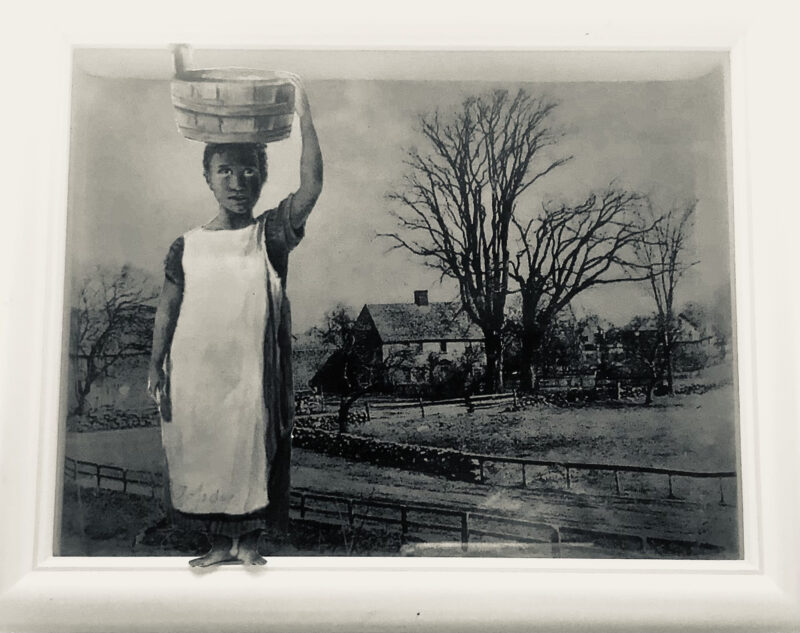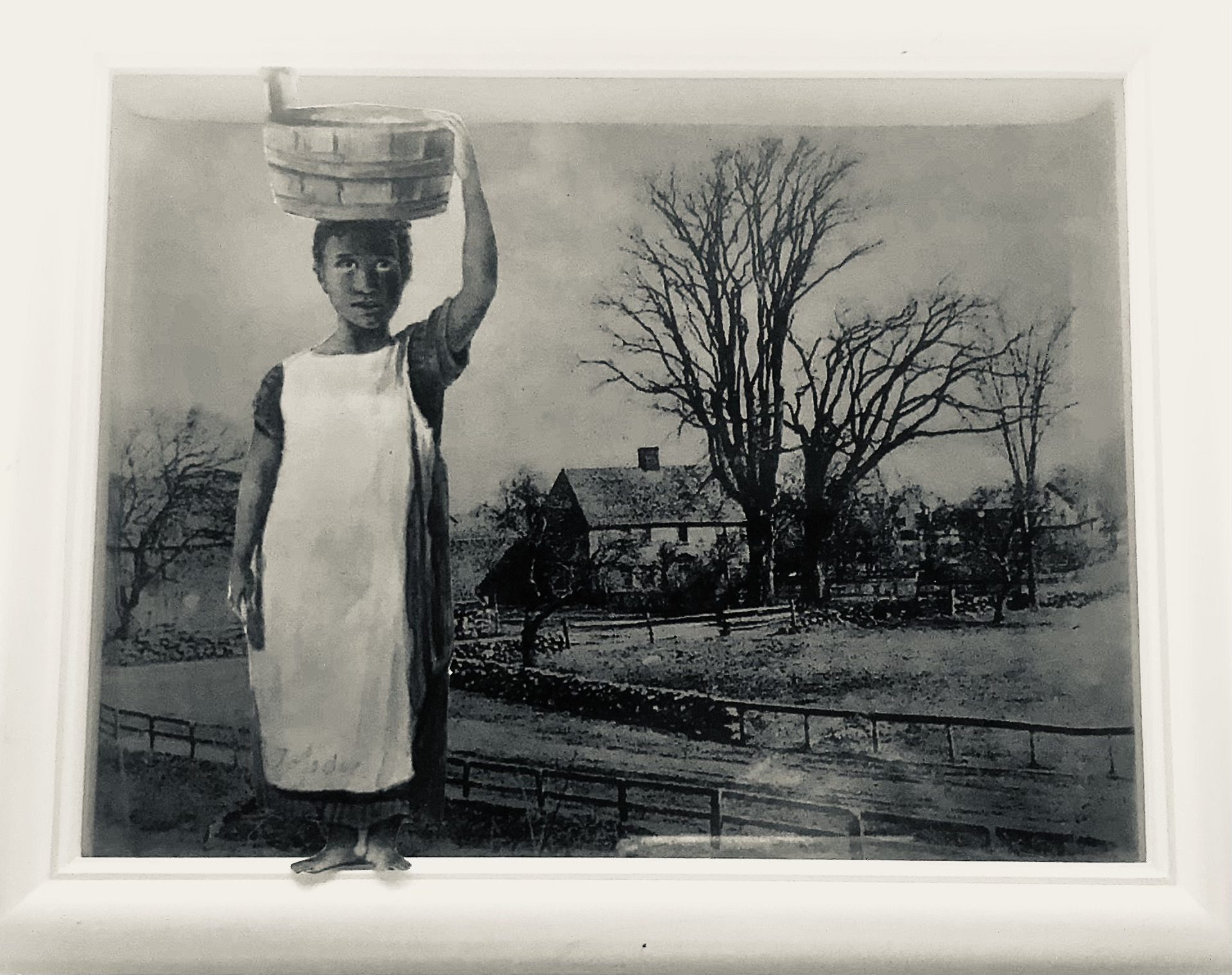"Enslaved Girl" collage

“To her private life
Only a few were privy.
A life lost and found.”
Nanny’s days were likely filled with exercising the many skills she had developed over the years, from the mundane to the complex, in this small New England town. Although we have almost no written record of her, and no more is likely to be found, let’s imagine what part of her days may have been like.
Sundays meant a walk to church, known then as a meeting-house, because the structure served dual purposes, as the center of the town’s government and its religious services. Nanny and most others went to the meeting-house as colonial Massachusetts was a theocracy and attendance was expected. William Tilden, author of The History of Medfield, Massachusetts, wrote about the separate section for non-Whites in Medfield’s Congregational church (Tilden). If a White parishioner paid attention, they might have seen Nanny climbing the steps in the back to get to the upper gallery where she joined her peers, other enslaved and free African Americans. And if she dared to sit in the White section, the person who offered her a seat might have been threatened with a financial fine if Medfield subscribed to the same policy as the town of Bridgewater, thirty miles south. Bridgewater’s Fourth Church of Christ congregation even added a separate entrance in addition to the stairwell placed in the very back of the building (Price).
Customs related to social status in New England and elsewhere changed at a glacial pace. There was still segregation in the early 19th century in some Massachusetts churches. For example, in 1808, many years after the end of Nanny’s life, “No negro was ever to sit-in any of the pews for whites” in the Massachusetts town of Hadley (Munn).
Back to Nanny, we find her rising daily at dawn, including Sundays.
She may have started her morning by emptying the Reverend Baxter’s chamber pot. Chamber pots were portable toilets used mostly at night. There was no indoor plumbing at the time, and a short trip to an outhouse could appear a long one in the middle of the night, especially midwinter. After he died, his wife Mercy kept the pot. It was listed in his household inventory after his death, “one pewter chamber pott 16 [shillings]” (Baxter).
Nanny would soon reignite the fire in the hearth by taking advantage of the burning coals from the previous day and would have carefully placed chopped seasoned wood on top of them. The pile she handled might have come from Baxter’s property near Holt Pond as he owned “a tract of wood land at noon hill” (Baxter). Done with that labor, Nanny would then fetch two buckets, one for each hand, and walk to the barn. It was time for the first of two milkings of the day as most homesteads at the time had a milking cow or two. When Baxter died in 1745, he still owned several cows, sheep and swine (Baxter).
Nanny then carried the milk buckets and poured the contents into pans in the household’s basement. It was now time to return to the kitchen and prepare and serve breakfast for the household. If there was any milk left at the end of the day, she would be charged with transforming the remains into cheese.
Depending on the time of year, Nanny would be harvesting varying fruits and vegetables. Judge Samuel Sewall, infamous for his role in the Salem Witch Trials, might have glimpsed Nanny working outdoors when he traveled through Medfield. The judge wrote in his diary in 1697 that he “viewed Mr. Baxter’s house, and the orchard Captain Frary hath given to the ministry, which lies very convenient; a living brook running by it [Vine Brook], and through Mr. Baxter’s” (Shipton).
In late September, the season’s yield of corn from the kitchen garden would have been harvested. Nanny knew that no part of the plant was allowed to go to waste. She stored the husks for later use as fresh filling for her mattress and for that of her master’s family. Their beds, however, more than likely had added features, an extra thick top layer known as the featherbed, along with feather filled pillows to rest their heads upon and bolsters to make up for the unevenness of the whole bed arrangement (Bed).
The cooking, milking, cheesemaking and harvesting were only a few of the
tasks she was likely to have labored over. She probably was engaged in provisioning as well, preserving food for the long cold winters. But what of her private life, or did she even have one? Did she have friends? Did she have a partner? Did she bear children?
As an enslaved person, if she did have infants and children, they could all have been legally sold, or given away, not an uncommon practice. There were even advertisements in Boston newspapers for doing just that, although the majority of such transactions were likely informal and without need of the press. Here are three examples, one for a baby girl, one for a young male, and one for a “Negro Wench, 17 years old…with Child.”
In 1706, the Boston News-Letter published the following:
“A Negro Infant Girl about Six Weeks Old, to be Given for the Bringing up: Inquire of John Campbell Post Master, and know further” (Boston News-Letter, September 30, 1706).
In 1772, “A MALE Negro Child of an excellent breed to be given away. Enquire of the Printer. (Boston Gazette, June 22, 1772)
TO BE SOLD,
An extraordinary likely Negro Wench, 17 years old, she can be warranted to be strong, healthy, and good-nature’d, has no notion of Freedom, has been always used to a Farmer’s kitchen and dairy, and is not known to have any failing, but being with Child, which is the only cause of her being sold:—Enquire of the Printer. (Continental Journal. March 1, 1781).
When setting down his will in February 1774, Baxter called for Nanny’s release from slavery upon his wife Mercy’s death. “To my Negro Woman, Nanny … I give her Freedom at my Wife’s decease.”
But three short months later, he officially added the following:
“To my Negro Woman, Nanny.…upon Condition my [said] Negro Woman shall not in all things Carry & behave herself dutifully and well towards her said Mistress my Wife, but behave herself undutifully Then she shall not have her freedom. But I give to my Wife full Power to Sell or dispose of her for Life at her discretion but in case She behaves well in all Things I order my will concerning her as above expressed to be in force”(Baxter).
Mercy Baxter died in 1769 (Massachusetts). As of yet, I have been unsuccessful in finding more information about Nanny. But I do believe that Nanny helped to build the town of Medfield. If it had not been for her free labor and that of others in the town, the minister might have decided to quit instead of remaining as the community’s cleric for half a century (History).
When pleading for a salary increase in 1709, Baxter wrote the community a letter in which he asked,
”Doe they mean [the] Ministers children should be given away as soon as they are born to be brought up for slaves, and their wives be sent out to work for their Livings.
“Or that ministers children should live in suffering, and want until they are able to work, and earn their Livings.
“Or that ministers should Labour with their hand to maintain their families.” (Congregational).
Reverend Baxter did not take to heart the wisdom found in almost all religions, “Do unto others as you would do unto yourself.”
Susan Elliott
Independent Researcher
EnslavedNewEngland.org
SOURCES:
Baxter, Reverend Joseph, 1745 – Suffolk County Probate, Suffolk County First Series, Record Books, 1628-1899, Docket 8263, Will 37:518, Probate and Letter 37:517, Inventory 38:404, Account 61:481. I first became aware of Nanny and the Reverend through the following article: DeSorgher, Richard, “This Old Town: When slavery existed in Medfield,” Hometown Weekly, April 6, 2016. Accessed February 20, 2020.
Bed. Winterthur Museum, Garden and Library in Wilmington, Delaware. 1760-1775. Pine, white; Maple; Pine; Mahogany; Maple, soft.Dimensions: 90.75 (H) , 78.5 (L) , 58 (W) http://museumcollection.winterthur.org/single-record.php?resultsperpage=20&view=catalog&srchtype=advanced&hasImage=on&ObjObjectName=&CreOrigin=&Earliest=&Latest=&CreCreatorLocal_tab=&materialsearch=&ObjObjectID=&ObjCategory=Furniture&DesMaterial_tab=&DesTechnique_tab=&AccCreditLineLocal=&CreMarkSignature=&recid=1955.0792&srchfld=&srchtxt=bed&id=5040&rownum=1&version=100&src=results-imagelink-only
Boston Gazette, published as The Boston-Gazette, and Country Journal.; Date: 06-22-1772; Issue: 898; Page: [4]; Location: Boston, Massachusetts.
Boston News-Letter (Boston, Massachusetts), no. 128, September 30, 1706: [2]. Readex: America’s Historical Newspapers. https://infoweb-newsbank-com.nehgs.idm.oclc.org/apps/readex/doc?p=EANX&docref=image/v2%3A1036CD221971FE08%40EANX-105661D2970C5F40%402344436-105661D2B33CC3B0%401-105661D2FB49851B%40Advertisement.
Congregational Library & Archives. Medfield, Mass. First Parish Unitarian Church Collection History. Loose records, 1709-1842. Correspondence regarding Rev. Baxter’s dissatisfaction with his ministry. 1709. Draft transcription by S. Elliott, Feb. 24, 2020.
Continental Journal, published as THE CONTINENTAL JOURNAL, THE WEEKLYADVERTISER.; Date: 03-01-1781; Issue: CCLXII; Page: [2]; Location: Boston, Massachusetts
This entire product and/or portions thereof are copyrighted by NewsBank and/or the American Antiquarian Society. 2004.
Custis, Mary Ann Randolph. “Enslaved Girl.” Watercolor, pencil, and ink on wove paper. 1830. The Colonial Williamsburg Foundation. — According to the Foundation, “‘Enslaved Girl’ is a poignant image of a young slave girl later freed by her owner. It was painted by Mary Anna Randolph Custis Lee who held a lifelong concern for the education of slaves.” Mary was the wife of General Robert E. Lee and the great-grand-grandaughter of Martha Washington! Little is known about the girl in the watercolor. To view the art work before the girl’s figure was removed from the landscape, use the link below.
“Enslaved Girl” collage. This collage was created from three pieces, the watercolor of a drawn-from-life real enslaved girl (see “Custis” in this list of sources for information on the watercolor itself), an early photograph of what had been the Baxter household (see “Early” in this list), and a shadow box. I created the collage to help think and write about Nanny’s life.
“Find A Grave Index,” database, FamilySearch (https://www.familysearch.org/ark:/61903/1:1:QVLH-TCR3 : 14 September 2023), Mercy Stoddard Baxter, ; Burial, Medfield, Norfolk, Massachusetts, United States of America, Vine Lake Cemetery; citing record ID 90968687, Find a Grave, http://www.findagrave.com.
First Parish Unitarian Universalist Church of Medfield, MA, “History of Our Congregation”. https://www.firstparishmedfield.org/our-history/history-of-our-congregation/
Massachusetts: Vital Records, 1620-1850 (Online Database: AmericanAncestors.org, New England Historic Genealogical Society, 2001-2016).
Medfield (Massachusetts) Historical Society. Early photograph of the then former Baxter homestead in the society’s archives.
Munn, Asa B. Seating Negroes in the Old Hadley Meeting-House. http://americancenturies.mass.edu/collection/itempage.jsp?itemid=19441&level=advanced&transcription=0&img=0
Price, George R. The Easton family of southeast Massachusetts: The dynamics surrounding five generations of human rights activism 1753–1935 surrounding five generations of human rights activism
1753–1935. Missoula, Montana: University of Montana, 2006. https://scholarworks.umt.edu/cgi/viewcontent.cgi?article=10634&context=etd.
Shipton, Clifford K. “Joseph Baxter.” Sibley’s Harvard graduates : biographical sketches of those who attended Harvard College … with bibliographical and other notes v.4 1690-1700. Harvard University Press, 1933, Cambridge, MA. p. 176. The Sewall diary quote was also cited by William Tilden, but searching copies of Sewall’s diary online, I did not locate it.
Tilden, William S. History of the Town of Medfield, Massachusetts, 1650-1886. G. H. Ellis, 1887, Boston, p. 115.
